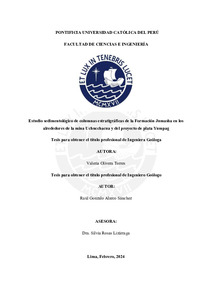| dc.contributor.advisor | Rosas Lizarraga, Blanca Silvia | |
| dc.contributor.author | Olivera Torres, Valeria | |
| dc.contributor.author | Alarco Sánchez, Raúl Gonzalo | |
| dc.date.accessioned | 2024-03-20T22:05:26Z | |
| dc.date.available | 2024-03-20T22:05:26Z | |
| dc.date.created | 2024 | |
| dc.date.issued | 2024-03-20 | |
| dc.identifier.uri | http://hdl.handle.net/20.500.12404/27364 | |
| dc.description.abstract | La Formación Jumasha es una secuencia de rocas carbonatadas que se extiende en el centro y
norte del Perú y es conocida por ser roca huésped o estar relacionada a ciertos yacimientos
minerales, algunos de los cuales se han convertido en proyectos o incluso minas.
Esta investigación presenta un estudio sedimentológico detallado de esta secuencia carbonatada
en la provincia Daniel Alcides Carrión en Pasco, donde se encuentra el proyecto Yumpag. El
objetivo general es describir las facies sedimentarias de esta formación levantando dos columnas
estratigráficas y correlacionarlas, permitiendo entender de mejor manera el sistema de deposición
sedimentario en el área de estudio y poder definir posibles nuevas áreas de interés.
Se identificaron 10 facies sedimentarias relacionadas a 4 ambientes de deposición dentro de una
rampa carbonatada, producto de un evento transgresivo de gran escala con otros transgresivos y
regresivos de menor escala. El Jumasha Inferior está compuesto principalmente de dolomías,
calizas de grano fino y margas. El Jumasha Medio lo componen calizas de grano medio a grueso,
peloidales y bioclásticas en la base y con algas y miliólidos en el techo. La base del Jumasha
Superior está formada por calizas de grano grueso ricas en Perouvianella Peruviana, miliólidos,
algas y gasterópodos, y su techo presenta predominancia de calizas de grano fino con
foraminíferos planctónicos y equinodermos.
Cada uno de los miembros se encuentra delimitado por sus respectivas secuencias marcadoras
margosas con contenido de cuarzo detrítico tamaño limo. Por otro lado, el techo del Jumasha
Medio y la base del Jumasha Superior serían las zonas más prospectivas por eventuales cuerpos
minerales de importancia económica, ya que por sus litologías son más propensas a reaccionar con los fluidos hidrotermales, además de presentar horizontes de rocas menos permeables que
evitan el paso de los fluidos, actuando como sello para la mineralización. | es_ES |
| dc.description.abstract | The Jumasha Formation is a sequence of carbonate rocks which extends into central and northern
Peru and is known to be host rock or to be related to some ore deposits, some of which have
become projects or even mines.
This investigation presents a detailed sedimentological study of this carbonate sequence in the
Daniel Alcides Carrión province in Pasco, where the Yumpag project is located. The general
objective is to describe the sedimentary facies of this formation by making two stratigraphic
columns and correlating them, allowing a better understanding of the sedimentary depositional
system in the study area and defining possible new areas of interest.
Ten sedimentary facies related to four depositional environments within a carbonate ramp were
identified, product of a large-scale transgressive event with other small-scale transgressive and
regressive events. The Lower Jumasha is composed mainly of dolostones, fine-grained limestones
and marls. The Middle Jumasha is composed of medium to coarse-grained peloidal and bioclastic
limestones at the base and algae and milliloid-rich limestones to the top. The base of the Upper
Jumasha is composed of coarse-grained Perouvianella Peruviana, miliolid, algae and gastropodrich
limestones, and its top is dominated by fine-grained limestones with planktonic foraminifera
and echinoderms.
Each of these members is delimited by their respective marly marker sequences with silt-sized
detrital quartz. The top of the Middle Jumasha and the base of the Upper Jumasha members would
be the most prospective areas for possible economically interesting ore bodies, since due to their
lithologies they are more prone to react with hydrothermal fluids, in addition to beds of less
permeable rocks that prevent the transport of fluids acting as a seal for the mineralization. | es_ES |
| dc.language.iso | spa | es_ES |
| dc.publisher | Pontificia Universidad Católica del Perú | es_ES |
| dc.rights | info:eu-repo/semantics/openAccess | es_ES |
| dc.rights.uri | http://creativecommons.org/licenses/by-nc-sa/2.5/pe/ | * |
| dc.subject | Minerales--Análisis | es_ES |
| dc.subject | Rocas--Análisis | es_ES |
| dc.subject | Petrología | es_ES |
| dc.title | Estudio sedimentológico de columnas estratigráficas de la Formación Jumasha en los alrededores de la mina Uchucchacua y del proyecto de plata Yumpag | es_ES |
| dc.type | info:eu-repo/semantics/bachelorThesis | es_ES |
| thesis.degree.name | Ingeniero Geólogo | es_ES |
| thesis.degree.level | Título Profesional | es_ES |
| thesis.degree.grantor | Pontificia Universidad Católica del Perú. Facultad de Ciencias e Ingeniería | es_ES |
| thesis.degree.discipline | Ingeniería Geológica | es_ES |
| renati.advisor.dni | 06987148 | |
| renati.advisor.orcid | https://orcid.org/0000-0002- 9791-9499 | es_ES |
| renati.author.dni | 76750647 | |
| renati.author.dni | 76750647 | |
| renati.discipline | 532146 | es_ES |
| renati.juror | Baby , Patrice Jean Francois | es_ES |
| renati.juror | Rosas Lizarraga, Blanca Silvia | es_ES |
| renati.juror | Valdivia Manchego, Mario | es_ES |
| renati.level | https://purl.org/pe-repo/renati/level#tituloProfesional | es_ES |
| renati.type | https://purl.org/pe-repo/renati/type#tesis | es_ES |
| dc.publisher.country | PE | es_ES |
| dc.subject.ocde | https://purl.org/pe-repo/ocde/ford#2.07.03 | es_ES |







